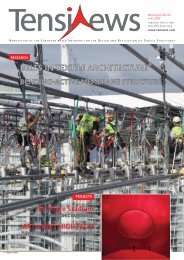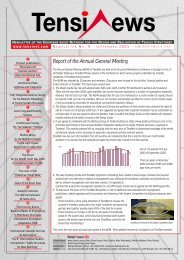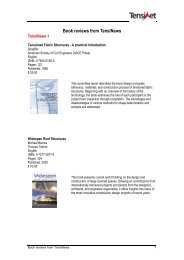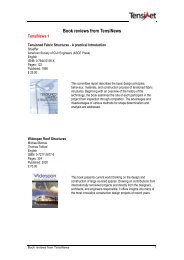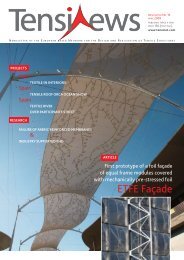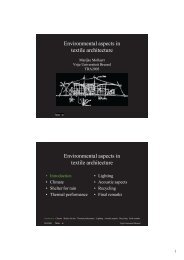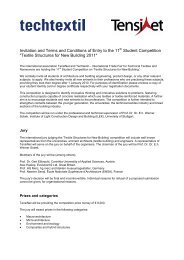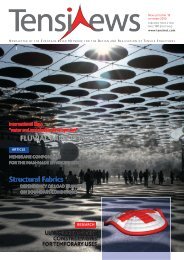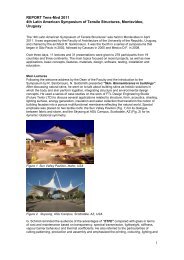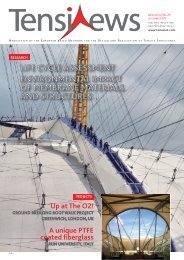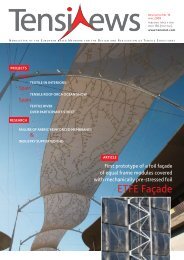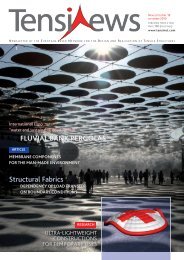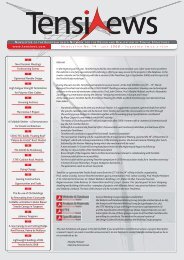TensiNews 13 - TensiNet
TensiNews 13 - TensiNet
TensiNews 13 - TensiNet
Create successful ePaper yourself
Turn your PDF publications into a flip-book with our unique Google optimized e-Paper software.
TENSINEWS NR. <strong>13</strong> – DECEMBER 2007<br />
4<br />
MAKING WIND …<br />
From Botticelli’s Birth of Venus<br />
Dynamic wind load simulation<br />
requires a numerical quantification<br />
of the properties of the natural<br />
phenomenon called “wind”.<br />
Wind<br />
Wind is motion of air. Air moves on<br />
a global scale because of differential<br />
heating over the equator and over<br />
the poles. At a fixed height above<br />
ground, the pressure of warmer air<br />
near the equator is greater than the<br />
pressure of colder air near the poles.<br />
This global air pressure gradient<br />
tends to move air towards the<br />
poles. Coriolis forces tend to deviate<br />
the pole-ward air streams to the<br />
right on the northern hemisphere<br />
and to the left on the southern<br />
hemisphere (going with the air).<br />
Beside global wind patterns we<br />
experience regional winds such as<br />
Föhn, Mistral, Schirocco, hurricanes,<br />
typhoons, sea-land, mountainvalley<br />
wind systems and more.<br />
High altitude winds become<br />
turbulent near the ground, where<br />
motion of air is perturbed by<br />
surface roughness features and<br />
differential heating. Wind loads on<br />
structures can fluctuate due to<br />
natural turbulence of the wind, due<br />
to turbulence created by nearby<br />
objects, and due to turbulence<br />
induced by the considered<br />
structure itself. The numerical<br />
simulations employ computational<br />
fluid dynamics (CFD) codes to<br />
evaluate the dynamic wind loads.<br />
Computational structural dynamics<br />
(CSD) codes calculate the effects<br />
of these loads on structures.<br />
Coupled fluid-structure interaction<br />
(FSI) analysis can detect aeroelastic<br />
instabilities when the<br />
structural deformations from wind<br />
loads interfere with the flow<br />
pattern. This article outlines the<br />
virtual design of structures under<br />
fluctuating wind loads.<br />
Aero-elastic instability<br />
Wind norms were developed which<br />
prescribe the static wind loads for<br />
the design of structures. The<br />
famous Tacoma Narrows Bridge<br />
experienced aero-elastic resonance<br />
under sustained winds, which made<br />
it fail spectacularly in 1940 a few<br />
months after its construction. This<br />
encouraged engineers to verify<br />
designs for aero-elastic instability.<br />
Failure of the Tacoma bridge (Wikipedia)<br />
While atmospheric wind tunnels<br />
can easily apply turbulent winds to<br />
reduced-scale rigid objects, they<br />
cannot be used easily when the<br />
building deformations interact with<br />
the aero-dynamic wind loads.<br />
This is because of conflicts of<br />
simultaneously modeling the<br />
aero-elastic similitude of both,<br />
the flow pattern and the structural<br />
vibrations at reduced scales.<br />
Fluid-structure interaction<br />
simulation, however, can overcome<br />
this handicap.<br />
Atmospheric wind tunnels<br />
In so-called “atmospheric wind<br />
tunnels” natural wind conditions<br />
are synthesized by manipulating<br />
inflow obstructions in the shape of<br />
“spires” and by adjusting the<br />
“roughness elements” of a<br />
roughness stretch ahead of the<br />
analyzed object.<br />
Atmospheric wind tunnel<br />
Atmospheric wind tunnel experiment<br />
(Courtesy IfH University of Karlsruhe, Prof. Ruck)<br />
In a dynamic CFD or FSI simulation,<br />
synthetic wind fields must be<br />
generated from known statistical<br />
wind data, such as local mean wind<br />
profiles, turbulence intensity<br />
profiles, covariance functions, wind<br />
power spectra and spatial flow<br />
coherence functions. These data<br />
can be derived from the individual<br />
local wind records supplied by<br />
meteorological stations.<br />
Wind records<br />
Wind velocity records, u i (t), can be<br />
transformed into a time-constant<br />
wind “mean” velocity, ū i , and a<br />
time-variable “fluctuation” gust<br />
wind velocity record u i’ (t)<br />
u i (t)=ū i +u i ’(t)<br />
Typical wind record with mean and standard<br />
deviation<br />
The duration for measuring the<br />
time-constant mean wind is often<br />
taken as 10 minutes. The<br />
fluctuations measure wind gusts of<br />
3 - 5 second duration. Turbulence<br />
intensity is defined as the standard<br />
deviation divided by the mean.<br />
Wind norm data include wind<br />
profiles and turbulence intensity<br />
profiles. These data are available at<br />
different sites from long standing<br />
series of wind recordings.<br />
Mean wind (10 min), gust wind (3-5 sec) and<br />
turbulence intensity profiles<br />
The vertical mean wind profiles, for<br />
example, are specified for different<br />
regions: urban, woodlands,<br />
seascapes. As indicated in the<br />
following figure, the uniform wind<br />
velocity is reached fastest over<br />
smooth seascapes.<br />
Different mean wind profiles<br />
Synthetic wind field<br />
generation<br />
Based on statistical wind<br />
quantities, two methods for the<br />
numerical generation of synthetic<br />
wind fields, or input time series of<br />
the wind fluctuations, have been<br />
implemented for PAM-Flow.<br />
They approximate best the known<br />
statistical wind data of naturally<br />
turbulent wind processes, as<br />
defined for various regions and<br />
locations:<br />
(1) “Auto-regressive processes of<br />
order p” (AR(p)), where a wind<br />
field depends on p past wind<br />
fields based on purely recursive<br />
and statistical considerations.<br />
(2) “Wave superposition<br />
techniques”, (using inverse FFT)<br />
where the atmospheric surfacelayer<br />
turbulence is based on 3D<br />
spectral tensors.<br />
Once the turbulent fluctuations<br />
have been synthesized at the<br />
chosen inflow boundary grid<br />
points, the mean velocities must be<br />
added to obtain the total synthetic<br />
wind records, which can now be<br />
interpolated to the fluid mesh<br />
points at the inflow boundary:<br />
Synthetic wind field from known mean<br />
profiles and calculated fluctuations<br />
Results.<br />
The mean wind velocity profile and<br />
snapshots of fluctuations obtained<br />
from a synthesized wind field using<br />
the AR(p) method is shown in the<br />
following figure.<br />
Generated numerical wind profiles<br />
The expected spatial and temporal<br />
correlations of the generated flow<br />
pattern are recognized in the darker<br />
curves to the right, while random<br />
wind velocity fluctuations (lighter<br />
curves) lack this correlation<br />
inherent to the wind.<br />
Applications.<br />
The AR(p) scheme is applied to<br />
flexible umbrella structures. Owing<br />
to the AR(p) scheme, the<br />
fluctuating mean wind profile can<br />
be applied instead of the<br />
conservative gust wind profile.<br />
A free-standing single umbrella<br />
that covers an area of<br />
approximately 29x29 m (a) is<br />
modeled in PAM-Solid (b) and in<br />
PAM-Flow (c) and it is subjected to<br />
a synthetic wind field. The umbrella<br />
is made of a very high strength




